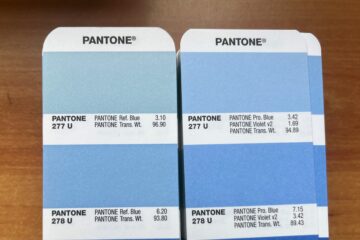Rather than making digital screens more tactile, why not make paper technological? Clever innovations mean that print is becoming a springboard to a whole new co-existent world for brands and industries to explore
Why The Revolution Will Be Printed
Thanks to technology – perhaps ironically – paper products continue to thrive. While speciality papers have enabled brands to appeal to multiple senses – for example, smooth textures that mimic velvet, rough textures that feel like sandpaper, varnishes that react to light and heat – the use of paper as a conduit for augmented reality (AR) truly bridges the gap between print and a digital device.
One project that encapsulates that approach perfectly is ‘Next Generation Paper’, a research project from a team at the University of Surrey. Led by Professor David Frohlich from the Digital World Research Centre*, the project uses AR and printed electronics to connect paper directly to the web with hotlinks, in what the team call second-generation (2G) and third-generation (3G) paper. This enables the reader to obtain related information on any nearby digital device, just by turning a page or touching the surface of the document, photograph, poster or book.
Currently, the project is exploring how this could connect the use of paper and screen-based information in tourism, where brochures and guides already co-exist with mobile apps, digital photography and online booking systems. The opportunities are virtually limitless, with multiple industries ideally placed to benefit from this approach – interactive textbooks in education; patient records in healthcare; music and entertainment; cultural interpretation in museums and galleries. All are real and practical possibilities.
“Everything’s getting closer, and there’s a co-existent connection between paper and technology,” explains Professor Frohlich. “So we’re trying to get away from the idea of paper versus screen; instead, putting paper and screen into the same product is the obvious next step.”
“You don’t expect a book to sing or show you a video. There is something truly magical about it.”
“Screens are preferred because they are ubiquitous now, but in the future, user interfaces may move away from touch screens,” says Dr Radu Sporea from the Advanced Technology Institute, who was part of the project team. “Print may have new uses when that happens.”
As Professor Frohlich explains it, 2G paper is optically recognised with a camera, triggering associated digital information to be played or displayed on a nearby device. Meanwhile, 3G paper dispenses with the camera altogether and contains tiny sensors printed or embedded in the fibres of the paper itself. This will trigger the same kind of associations around it.
“Essentially, you’re taking a typically static object, such as a book, and allowing it to interact with the world, and with other devices around it,” says Frohlich. “I believe augmented paper will be a commercial reality within three to five years. 2G will come first, and 3G will follow. Touch-sensitive paper, with hotlinks, is our holy grail: as soon as you know exactly where people are touching and pointing in a book, you can start to instrument the entire surface. At the moment, we have a shifting interface between the book and the smartphone. But, in future, the objective is to put the whole interface within the printed book.”
The project was funded by the Engineering and Physical Sciences Research Council, part of the UK government’s commitment to developing the digital economy. The end result is an augmented guidebook, or a-book, to Cornwall, with extra pictures, videos and interviews – it was released as an experimental demo in early 2019, in association with Bradt Travel Guides.
Despite the freedoms offered by the digital interface, Professor Frohlich remains passionate about paper. “There is potentially so much distraction associated with the digital experience,” he observes. “Paper products, such as books and magazines, are often actively chosen to escape from social media because paper will never interrupt you. Even our product has to be manually initiated to obtain the additional information. We’re trying to design a new kind of reading behaviour involving paper and screen and, in doing so, we hope to make media tangible again. You don’t expect a book or magazine to sing or show you a video, and there is something truly magical about that.”
Case study: ‘McTrax’ – interactive placemats with McDonalds
Robert Slot, Director of Tech at TBWA\NEBOKO in Amsterdam, describes how his team combined conductive ink, a McDonald’s paper tray liner and a digital interface to create McTrax – a beats-creating experience to engage customers
Thanks to Novalia’s touch-sensitive ink technology, paper can be truly interactive. Using this ink, you can print a whole host of buttons and touchpads on a piece of paper which, when synced to a digital device, can be used just like a musical keyboard.
McDonald’s came to us because it wanted to create an in-restaurant experience to engage its younger audience. It was therefore essential that we used an item that they would encounter in the restaurant as part of any meal.
In our research into what moves the McDonald’s target audience, we discovered that they were interested in DJing and music production. So to take advantage of these interests, we came up with the idea of turning the tray liner that came with a meal into a beat machine.
As soon as we had the idea, we started to search for suitable partners. Together with our technical partner on this job (This Page Amsterdam), we connected with Novalia, whose technology allowed us to make use of actual paper – perfect for what we envisioned for the tray liner.
Interactivity on screens is something that most customers expect in this digital era. Paper allowed us to make something that is tactile and interactive, encouraging engagement with something surprising. It’s harder to achieve that sort of magical experience on a screen, where haptics is often compromised in favour of interactivity. Everybody who experienced the tray liner was amazed that something like this was actually possible.
From the moment the press heard about the McTrax, the media attention was big. In the first week after the launch, McTrax was covered in titles such as Vice and Fortune. From there it got picked up in music titles such as DJ Mag, as well as in the mainstream media. Although it depends on the idea and the objectives, this technology and similar analogue technological developments prove that any surface can become interactive.
Combined with technologies such as augmented reality, innovative print technologies really help to break down conventional borders in our thinking about media and the materials we use.
Looking to the future: Three technologies you might see in print soon
1. Photonic inks
These inks change colour electronically in response to finger pressure or sunlight, thus creating ‘invisible’ printing. Such inks have amazing security potential in passports, for example, and will change the landscape for ‘secret messaging’. Brands are already using the technology: Ogilvy South Africa produced a children’s book called The Book of Dirt for laundry detergent brand Omo. The text and images only appeared when the reader smeared soil across its pages.

2. Conductive inks
By acting as a circuit, paper printed with conductive ink essentially becomes a touch-screen display (as with the McTrax case study above). Marcin Ratajczak, co-founder of INURU, has developed light-up inks that can be printed on anything. “The technology can be applied to any surface: labels, packaging, business cards, books, marketing materials, car interiors and furniture,” he explains. “INU-INK incorporates many movements as activation mechanisms. Touch is one; reaction to turning the page is another. Touch gives readers a visual feedback from previously static surfaces.”
3. 3D printing
It’s still in its infancy, but this technology has great potential within packaging where personalisation is key. Expect to be able to design and customise your own packages in the not-too-distant future.
*Supported by Professor Miroslaw Bober from the Centre for Vision, Speech and Signal Processing and Dr Radu Sporea from the Advanced Technology Institute

